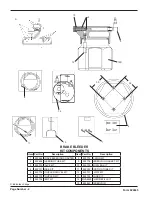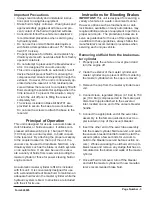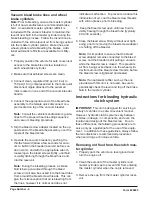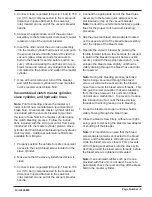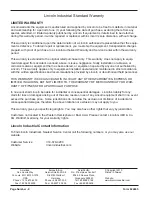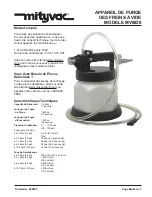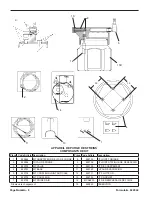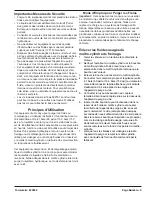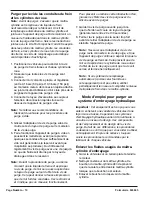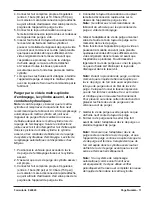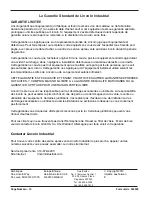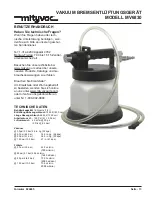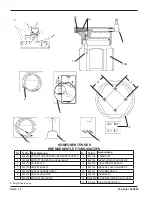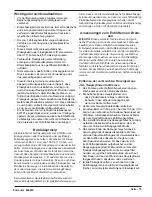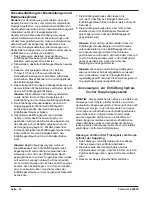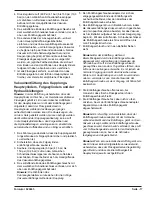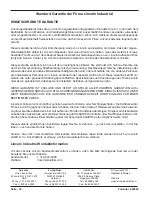
Page Number - 3
Form 824845
Important Precautions
• Always read carefully and understand instruc-
tions prior to using this equipment
• Brake fluid is highly corrosive. Wear gloves and
approved safety goggles at all times, and pre-
vent contact of the fluid with painted surfaces.
• Consult and follow the vehicle manufacturer’s
recommended procedures when servicing any
hydraulic system.
• Do not use this unit with flammable liquids or
with fluids at temperatures above 175° Fahren-
heit (80° Celsius).
• Properly dispose of old fluids, and replenish hy-
draulic systems with new brake fluid from freshly
opened containers.
• Do not attempt to pressurize the bleeder/evacu-
ator. It is designed for vacuum use only.
• This unit is equipped with an automatic shut-off
device that will prevent fluid from entering the
compressed air stream and ejecting through the
exhaust. However, if the unit is continuously op-
erated when the reservoir is full, residual pres-
sure will allow the reservoir to completely fill with
fluid, creating the potential for spillage when the
lid is removed. To prevent this situation, empty
or turn the unit off prior to filling the reservoir
completely full.
• The screws included in Base Kit 822701 are
provided to secure the base to a work surface.
Do not use the screws to attach the base to the
reservoir.
Principal of Operation
This unit is designed for use as a vacuum brake or
clutch bleeder, or fluid evacuator. It utilizes com-
pressed air between 60 psi (4.1 bar)and 150 psi
(10.3 bar), and a venturi system, to build vacuum
in the reservoir. By attaching the proper accessory
to the coupler located on the top of the unit, the
vacuum can be used to drain brake fluid from a hy-
draulic system such as the brake or clutch systems
on an automobile. It can also be used to evacu-
ate a variety of fluids from reservoirs including the
master cylinder or those for power steering fluid or
engine coolant.
An automatic master cylinder refill kit is included
with this unit. It is conveniently designed for use
with a standard bottle of brake fluid, to maintain an
adequate fluid level in the master cylinder while the
hydraulic system is bled. Instructions are included
with the kit for its use.
Instructions for Bleeding Brakes
IMPORTANT:
This unit is designed for servicing a
variety of vehicles in a safe, convenient manner.
However, options such as load sensors or anti-
lock brakes, available on many automobiles, may
require additional steps or equipment to perform a
proper service job. The procedures below are to
serve as guidelines for the use of this equipment,
in addition to these guidelines, always follow the
manufacturer’s recommended procedures when
servicing each unique vehicle.
Removing old fluid from the brake mas-
ter cylinder
1. Properly park the vehicle on level ground and
turn the engine off.
2. Clean the exterior of the master cylinder and
master cylinder cap to prevent dirt from entering
the master cylinder when the cap is removed.
3. Remove the cap from the master cylinder reser-
voir.
4. Connect clean, regulated (60 psi (4.1 bar) to 150
psi (10.3 bar)) compressed air to the male quick
disconnect nipple attached to the swivel air
inlet, located on one end of the vacuum bleeder
handle.
5. Connect the appropriate end of the evac tube
assembly to the female quick disconnect cou-
pler located on top of the vacuum bleeder.
6. Insert the other end of the evac tube assembly
into the master cylinder fluid reservoir, and push
the vacuum bleeder throttle forward to start the
vacuum (allow a few seconds for vacuum to
build in the bleeder reservoir before suction oc-
curs). While evacuating the old fluid, stir it up to
break loose and remove any sludge that has ac-
cumulated on the bottom and walls of the master
cylinder.
7. Once all fluid is removed, turn off the bleeder
and refill the master cylinder with new manufac-
turer’s recommended brake fluid.


